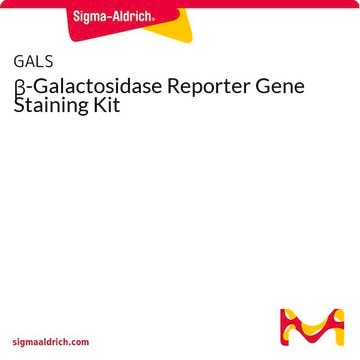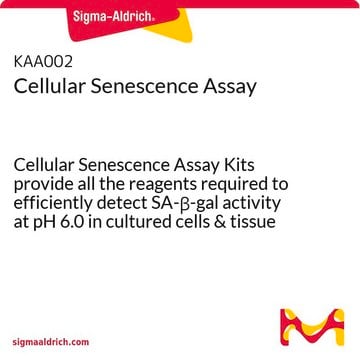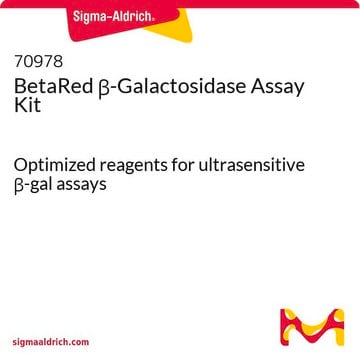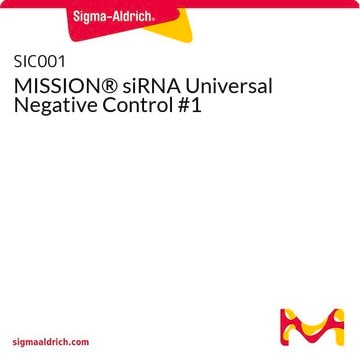This kit has not been tested for use with confocal or fluorescent microscopes. X-gal staining does not involve a specific wavelength and it would be up to the end user to determine suitability. Note below, in a previously submitted question, that this kit has not been tested for dual staining with fluorescent dyes.
Wichtige Dokumente
CS0030
Histochemisches Färbungskit für Seneszenzzellen
sufficient for 100 tests
Synonym(e):
Senescent cells IHC kit, cellular β-galactosidase probe
Größe auswählen
439,00 €
Voraussichtliches Versanddatum31. März 2025
Größe auswählen
About This Item
439,00 €
Voraussichtliches Versanddatum31. März 2025
Empfohlene Produkte
Verwendung
sufficient for 100 tests
Qualitätsniveau
Verpackung
pkg of 1 kit
Lagerbedingungen
dry at room temperature
Nachweisverfahren
colorimetric
Versandbedingung
dry ice
Lagertemp.
−20°C
Allgemeine Beschreibung
Anwendung
- Seneszenz-assoziierter β-Galactosidase-Assay
- Prüfen auf Seneszenz in humanen Bauchspeicheldrüsenkrebszellen
- Stammzellen aus Fettgewebe (ADSC)
- CBMSC-Zellen
Biochem./physiol. Wirkung
Rechtliche Hinweise
Nur Kit-Komponenten
- X-gal solution 4 mL
- Staining Solution, 10X 15 mL
- Fixation Buffer 10x 15 mL
- Reagent B 1.5 mL
- Reagent C 1.5 mL
- Dulbecco's Phosphate Buffered Saline (PBS) 10x 60 mL
Ähnliches Produkt
Signalwort
Danger
Gefahreneinstufungen
Acute Tox. 3 Inhalation - Acute Tox. 4 Dermal - Acute Tox. 4 Oral - Aquatic Chronic 3 - Carc. 1B - Eye Dam. 1 - Muta. 2 - Resp. Sens. 1 - Skin Corr. 1B - Skin Sens. 1 - STOT SE 3
Zielorgane
Respiratory system
Zusätzliche Gefahrenhinweise
Lagerklassenschlüssel
6.1C - Combustible acute toxic Cat.3 / toxic compounds or compounds which causing chronic effects
Hier finden Sie alle aktuellen Versionen:
Analysenzertifikate (COA)
Die passende Version wird nicht angezeigt?
Wenn Sie eine bestimmte Version benötigen, können Sie anhand der Lot- oder Chargennummer nach einem spezifischen Zertifikat suchen.
Besitzen Sie dieses Produkt bereits?
In der Dokumentenbibliothek finden Sie die Dokumentation zu den Produkten, die Sie kürzlich erworben haben.
Kunden haben sich ebenfalls angesehen
Artikel
Zellbasierte Assays für Zellproliferation (BrdU, MTT, WST1), Zellviabilität und Zytotoxizitätsversuche für Anwendungen in der Krebs- und Stammzellforschung und in den Neurowissenschaften.
Cell based assays for cell proliferation (BrdU, MTT, WST1), cell viability and cytotoxicity experiments for applications in cancer, neuroscience and stem cell research.
-
Can we use confocal/basic fluorescent microscope for capturing the expression of Beta Galactosidase after using this staining kit?
1 Antwort-
Hilfreich?
-
-
Is there a method to extract the stain from cells when using the Senescence Cells Histochemical Staining Kit (Catalog Number CS0030) for cells in transwell inserts where cell counting is not feasible?
1 Antwort-
The CS0030 kit is intended for cell visualization using a microscope and does not include a specific procedure for dye extraction from cells.
Hilfreich?
-
-
Does kit CS0030 include a counterstain?
1 Antwort-
No, the CS0030 kit does not include a counterstain.
Hilfreich?
-
-
Is there a protocol for staining HCHO-fixed tissue culture cells, specifically for cells growing on coverslips or slides?
1 Antwort-
For staining purposes, there is no significant difference between staining wells attached to a culture plate or cells attached to a coverslip or glass slide. The primary difference lies in the amount of reagent required for the staining. It is advisable to ensure adequate coverage of the cells, and the insert contains a table that provides guidance on the amount of reagent required for staining.
Hilfreich?
-
-
I have been using it well for a long time. thank you I want to stain beta-gal staining and apoptosis-related IF together. Is there a recommended order or method?
1 Antwort-
The CS0030 kit has not been tested for use in dual staining, it would be up to the end user to determine suitability. There are several factors to consider with regard to attempting this modification.
1. The CS0030 includes a fixation step. Cells are not viable at the time of staining. Therefore any 'live cell' fluorescent stain would not be suitable following fixation.
2. There is an incubation period of 2 hours to overnight. This may deplete or cause certain fluorescent dyes to fade which would mean a 'one-time use' for visualizing the IF-stained cells.
3. The staining mechanism for CS0030 is pH dependent. This may not be suitable for some fluorescent dyes.
4. One possible robust fluorescent stain to consider would be DAPI, which could be applied following the b-gal staining. DAPI will stain fixed cells and can be preserved if stored in the dark.To discuss further, please navigate to the link https://www.sigmaaldrich.com/techservice, and click on "Product Technical Inquiries" under the Products Section with all the required information so that a member of the Technical Service team can reach out to assist further.
Hilfreich?
-
-
Can Product CS0030, Senescence Cells Histochemical Staining Kit be used with fixed cells/tissues?
1 Antwort-
Product CS0030, Senescence Cells Histochemical Staining Kit was designed for use with fresh (not-fixed) cells. The kit contains a fixation buffer to fix the cells. It is 10% formaldehyde, 1% glutaraldehyde in DPBS at 1X. The cells will be fixed prior to staining. The staining will show the beta-galactosidase activity that was present at the time of fixation.We tested the kit only on cells and we have no experience with tissue sections. The following papers use an assay for ßGAL on tissue sections which suggests that the kit will work with tissue sections.Castro P, et al., Interleukin-8 expression is increased in senescent prostatic epithelial cells and promotes the development of benign prostatic hyperplasia. Prostate, 60(2), 153-159 (2004).Chen, Z., et al., Crucial role of p53-dependent cellular senescence in suppression of Pten-deficient tumorigenesis. Nature, 436, 725-730 (2005).
Hilfreich?
-
-
What is the Department of Transportation shipping information for this product?
1 Antwort-
Transportation information can be found in Section 14 of the product's (M)SDS.To access the shipping information for this material, use the link on the product detail page for the product.
Hilfreich?
-
Aktive Filter
Unser Team von Wissenschaftlern verfügt über Erfahrung in allen Forschungsbereichen einschließlich Life Science, Materialwissenschaften, chemischer Synthese, Chromatographie, Analytik und vielen mehr..
Setzen Sie sich mit dem technischen Dienst in Verbindung.












